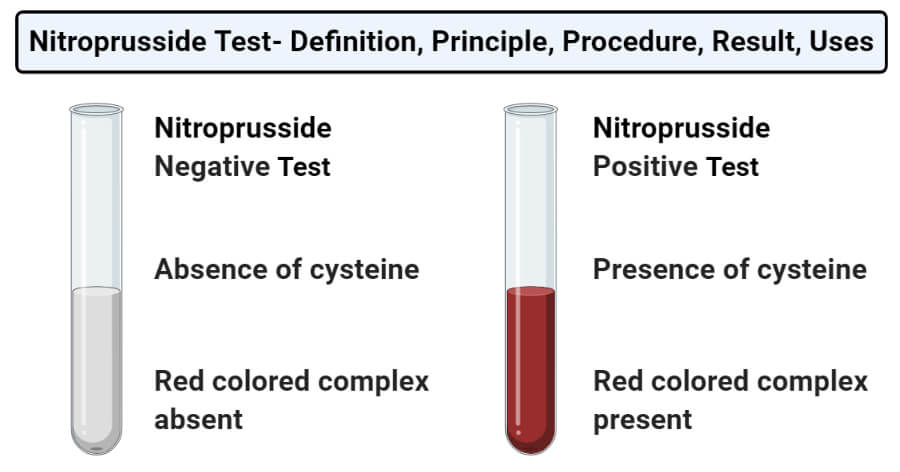Interesting Science Videos
Nitroprusside Test Definition
Nitroprusside test is a biochemical test used for the detection of the free –SH groups in amino acids or the cysteine amino acid in a protein. The test is a specific test for cysteine as it is the only amino acid with a free –SH group in the structure. The test, however, is not specific to proteins and amino acids as it can detect compounds like ketones. The test is a colored reaction of amino acid where the free –SH group in the amino acid reacts with the nitroprusside reagent to form a red-colored complex. Cysteine and methionine are two amino acids with –SH groups but the –SH group in the methionine molecule is involved in the thioester linkage which is difficult to break and thus, cannot be detected by this test. The test can also be used for the differentiation between cysteine and cystine as cysteine gives a positive result to this test, but cystine doesn’t.
Objectives of Nitroprusside Test
- To detect the presence of amino acid cysteine in a protein solution.
- To differentiate between the amino acids cysteine and cystine.
- To detect the presence of cysteine in the urine sample and diagnose cystinuria.
Principle of Nitroprusside Test
The test is based on the detection of free sulfur atoms in a solution as a result of the degradation of the –SH group. Nitroprusside is a complex anion consisting of an octahedral ferrous center which is surrounded by five tightly bound cyanide groups. The molecule, when combined with a sulfur atom forms a violet or red-colored complex. The action of a strong alkali releases SH group foud in cysteine molecule. The sulfur then reacts with the nitroprusside ion to form a red-colored compound. Some proteins might not give a positive result immediately, and in that case, the solution should be heated as these proteins might require heat coagulation to release the –SH group.
Reaction
Cysteine + 2NaOH → Serine + Na2S + H2O
Na2[Fe(CN)5NO] + Na2S → Na4[Fe(CN)5NOS] (red coloured complex)
Requirements
Reagent
- 2% freshly prepared Sodium Nitroprusside
- Concentrated Sodium hydroxide
- Sample (1% cysteine)
Materials Required
- Test tubes
- Test tube stand
- Pipettes
- Water bath
Procedure of Nitroprusside Test
- 2 ml of the amino acid solution or the sample is added to a test tube.
- To the test tube, 0.5 ml of the freshly prepared sodium nitroprusside is added and mixed thoroughly.
- Now, 0.5 ml of the concentrated sodium hydroxide is added. If a positive result is not observed immediately, the test tube can be heated in a water bath for 2 minutes.
- The test tube is observed for the color change or the formation of a colored complex.
Result and Interpretation of Nitroprusside Test

- Positive result: A positive result in the nitroprusside test is indicated by the appearance of a red-colored complex. The color formation confirms the presence of cysteine.
- Negative result: A negative result in the nitroprusside test is indicated by the absence of a red-colored solution. This indicates the absence of cysteine.
Uses of Nitroprusside Test
- Nitroprusside test is an analytical test for the detection of cysteine or cysteine-containing proteins in a sample.
- The test can also be used in the diagnosis of cystinuria as the presence of cysteine in urine is a pathological feature of the disease.
- The nitroprusside test also detects compounds like ketoacids and ketones in blood and urine that helps in the determination of the degree of ketonuria and ketonemia.
Read Also: Ketones in urine (ketonuria) and Ketones in urine test
Limitations of Nitroprusside Test
- The test doesn’t give a positive result with methionine as the –SH group in methionine is not free as it is involved in the thioester linkages.
- Some proteins might require heat coagulation for the liberation of the –SH group.
References
- Nigam S. C. and Omkar (2003). Experimental Animal Physiology and Biochemistry. New Age International Pvt. Limited. New Delhi.
- D (2012). Biochemistry. Fourteenth Edition. Academic Publishers. Kolkata.
- Tiwari, A. (2015). Practical Biochemistry. LAP Lambert Academic Publishing.

no mention of using urine or adding urine or the amount of urine directions for collecting urine or whether to add the other ingredients to the urine. and directions for the water bath temp or method of heating . Also where to get the nitroprusside.